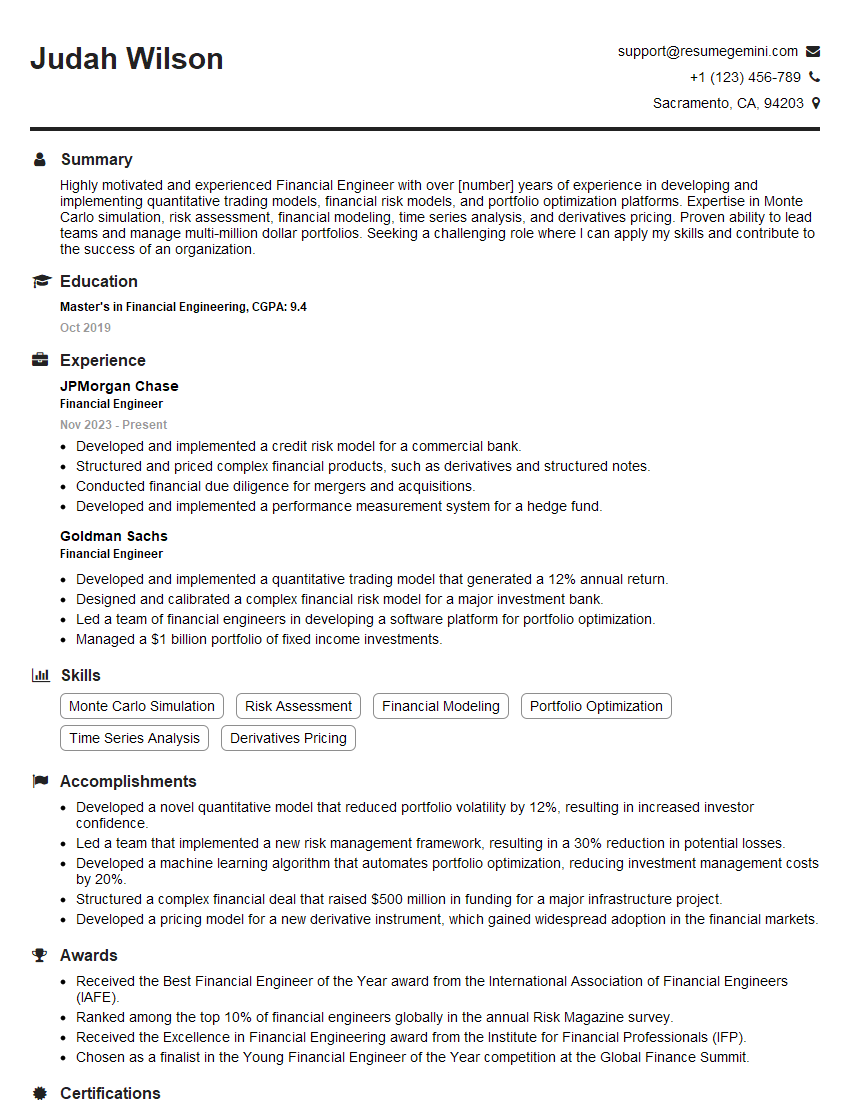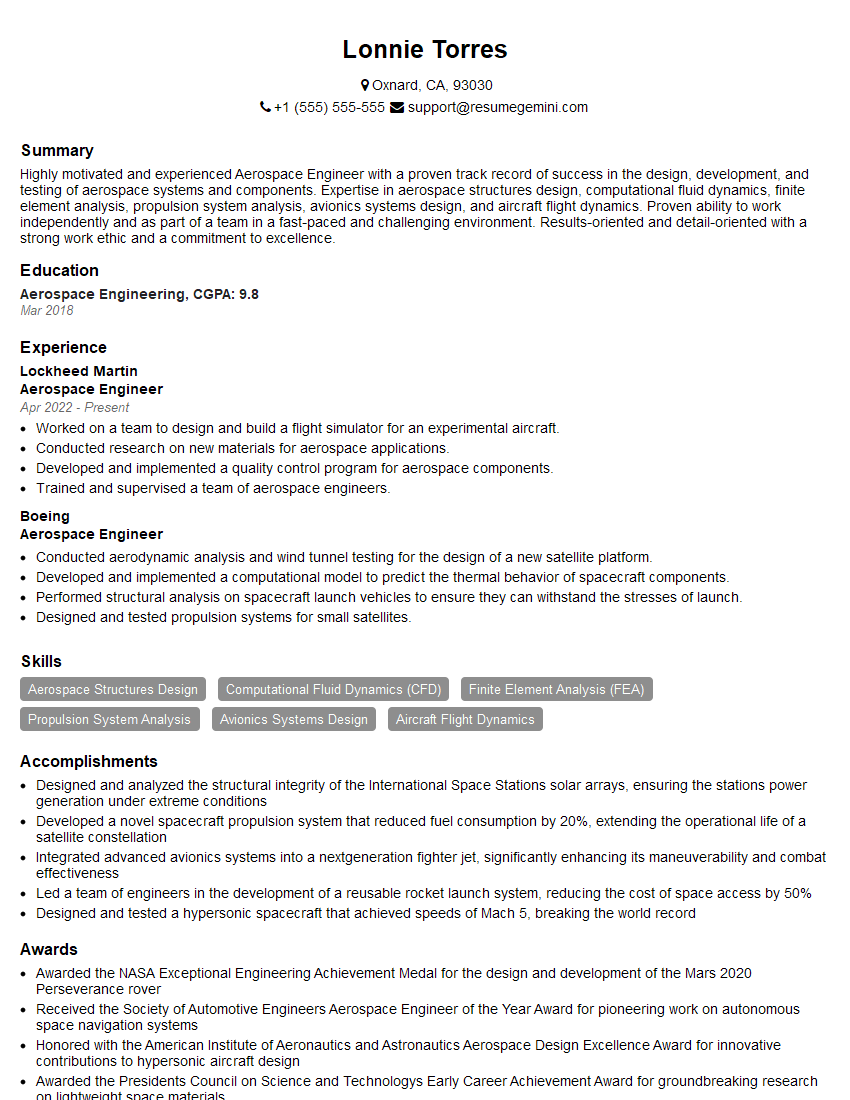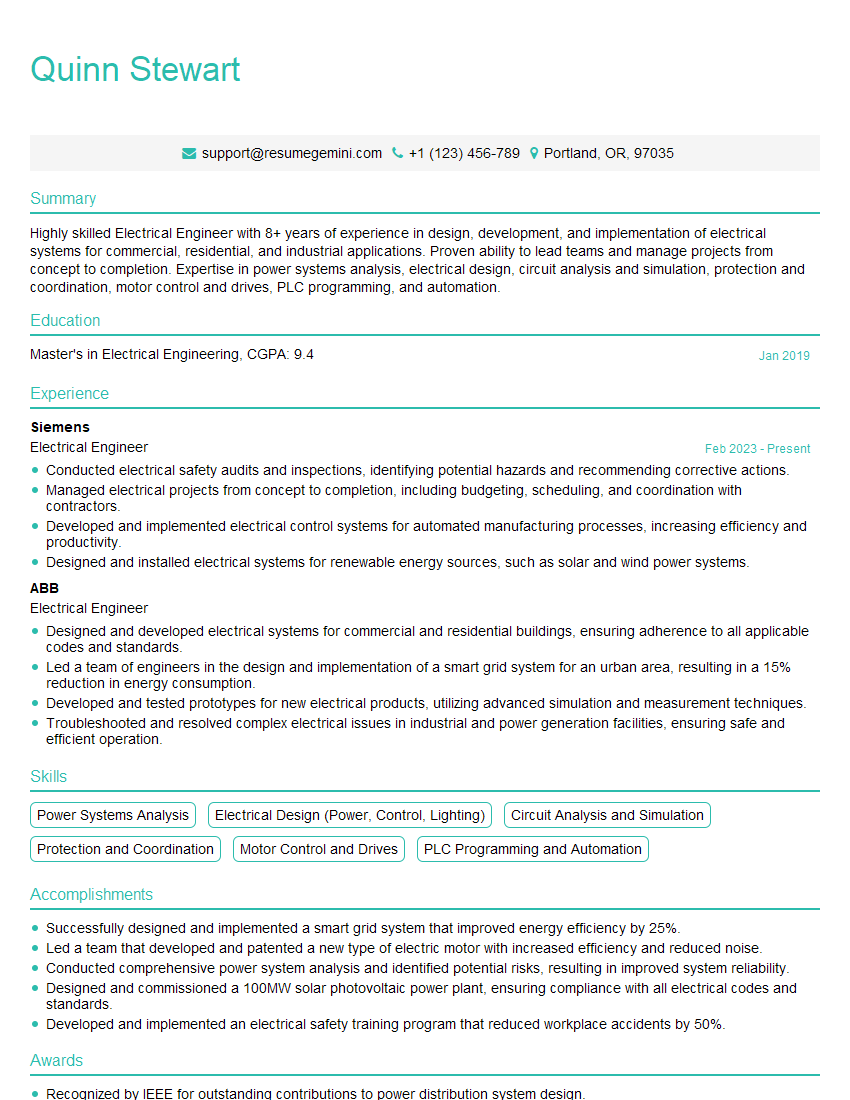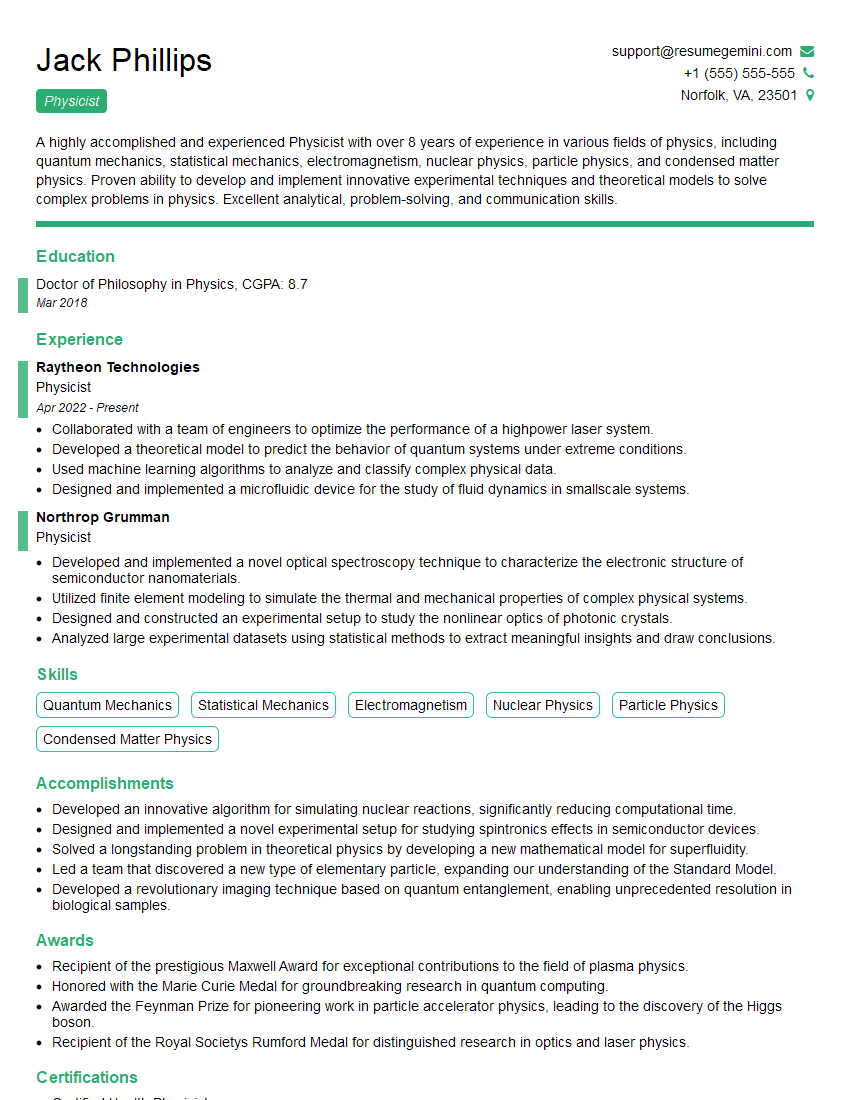Are you ready to stand out in your next interview? Understanding and preparing for Vector Calculus interview questions is a game-changer. In this blog, we’ve compiled key questions and expert advice to help you showcase your skills with confidence and precision. Let’s get started on your journey to acing the interview.
Questions Asked in Vector Calculus Interview
Q 1. Define the gradient of a scalar field and explain its geometric interpretation.
The gradient of a scalar field, denoted as ∇f, is a vector field that points in the direction of the greatest rate of increase of the scalar field f. Its magnitude represents the rate of increase in that direction. Imagine you’re standing on a hill; the gradient at your location would point directly uphill, and its magnitude would indicate the steepness of the slope.
Geometric Interpretation: The gradient is always perpendicular to the level curves (or surfaces) of the scalar field. Think of contour lines on a map: the gradient at any point is perpendicular to the contour line passing through that point, pointing towards higher altitudes.
Example: Consider the scalar field f(x, y) = x² + y². Its gradient is ∇f = (2x, 2y). At the point (1, 1), the gradient is (2, 2), pointing away from the origin (the direction of steepest ascent).
Q 2. Explain the divergence theorem and provide a practical application.
The Divergence Theorem, also known as Gauss’s Theorem, relates the flux of a vector field through a closed surface to the volume integral of the divergence of the field within that surface. In simpler terms, it states that the total outward flux of a vector field across a closed surface is equal to the total amount of the field’s source or sink within the enclosed volume.
Mathematical Statement: ∬S F ⋅ dS = ∭V (∇ ⋅ F) dV, where F is the vector field, S is the closed surface, V is the enclosed volume, and ∇ ⋅ F is the divergence of F.
Practical Application: Fluid dynamics is a prime example. Imagine a fluid flowing through a pipe. The divergence theorem allows us to calculate the total amount of fluid flowing out of a section of the pipe by integrating the divergence of the fluid velocity field over the volume of that section. This is much easier than trying to calculate the flux directly across the pipe’s surface.
Q 3. What is the curl of a vector field, and what does it represent physically?
The curl of a vector field, denoted as ∇ × F, is another vector field that measures the rotation or circulation of the original vector field. It’s a way to quantify how much the vector field ‘twirls’ around a point.
Physical Representation: Imagine placing a small paddle wheel in the vector field. If the paddle wheel rotates, the curl is non-zero; the direction of the curl vector indicates the axis of rotation, and its magnitude represents the rotational speed.
Example: Consider a whirlpool. The velocity field of the water has a non-zero curl, indicating rotation. A field with zero curl is called irrotational.
Q 4. State Stokes’ theorem and illustrate its use in a specific example.
Stokes’ Theorem connects a line integral around a closed curve to a surface integral over a surface bounded by that curve. It essentially states that the circulation of a vector field around a closed curve is equal to the flux of the curl of the field through any surface bounded by the curve.
Mathematical Statement: ∮C F ⋅ dr = ∬S (∇ × F) ⋅ dS, where F is the vector field, C is the closed curve, and S is any surface bounded by C.
Example: Calculating the work done by a force field on a particle moving along a closed path. Instead of directly calculating the line integral, we can find the curl of the force field and integrate it over a surface bounded by the path. This can significantly simplify the calculation.
Q 5. Calculate the line integral of a vector field along a given curve.
The line integral of a vector field F along a curve C is calculated by parameterizing the curve and integrating the dot product of the vector field and the tangent vector to the curve along the curve’s length.
Procedure:
- Parameterize the curve: Express the curve C as a vector function r(t) = (x(t), y(t), z(t)), where a ≤ t ≤ b.
- Compute the tangent vector: Find the derivative r‘(t).
- Evaluate the vector field along the curve: Substitute r(t) into F to get F(r(t)).
- Compute the dot product: Find F(r(t)) ⋅ r‘(t).
- Integrate: Evaluate the definite integral ∫ab F(r(t)) ⋅ r‘(t) dt.
Example: Let F(x, y) = (x, y) and C be the unit circle. Parameterizing C as r(t) = (cos t, sin t), 0 ≤ t ≤ 2π, we get the line integral as ∫02π (cos t, sin t) ⋅ (-sin t, cos t) dt = ∫02π 0 dt = 0.
Q 6. How do you compute the surface integral of a vector field over a given surface?
The surface integral of a vector field F over a surface S is computed by parameterizing the surface and integrating the dot product of the vector field and the surface normal vector over the surface area.
Procedure:
- Parameterize the surface: Represent the surface S using a parameterization r(u, v) = (x(u, v), y(u, v), z(u, v)) where (u, v) belongs to a region D in the uv-plane.
- Compute the normal vector: Find the cross product of the partial derivatives ru and rv to obtain the normal vector n = ru × rv.
- Evaluate the vector field on the surface: Substitute r(u, v) into F to get F(r(u, v)).
- Compute the dot product: Calculate F(r(u, v)) ⋅ n.
- Integrate: Evaluate the double integral ∬D F(r(u, v)) ⋅ n dA.
This process involves understanding the surface’s orientation, which determines the direction of the normal vector. The integral represents the flux of the vector field across the surface.
Q 7. Explain the concept of a conservative vector field and its properties.
A conservative vector field is a vector field that is the gradient of some scalar field (called a potential function). In other words, there exists a scalar function f such that F = ∇f.
Properties:
- Path Independence: The line integral of a conservative vector field between two points is independent of the path taken between those points. The integral only depends on the initial and final positions.
- Zero Curl: The curl of a conservative vector field is always zero (∇ × F = 0). This is a necessary and sufficient condition for a vector field to be conservative in a simply connected region (a region without holes).
- Potential Function Exists: As mentioned, a conservative field always has an associated potential function.
Real-world example: The gravitational field is a classic example of a conservative vector field. The work done by gravity on an object moving between two points is independent of the path taken.
Q 8. Determine if a given vector field is conservative. Justify your answer.
A vector field is conservative if it’s the gradient of a scalar potential function. Think of it like this: if you’re climbing a hill, the gradient points in the steepest direction uphill. A conservative field is one where the path you take to get to a certain point doesn’t affect the total ‘work’ done (in physics terms, the line integral is path-independent). To determine if a vector field F = P(x,y)i + Q(x,y)j (in 2D, easily extendable to 3D) is conservative, we check if its partial derivatives satisfy the condition:
∂P/∂y = ∂Q/∂x
If this equation holds true, the field is likely conservative (in simply connected regions). If it doesn’t, the field is definitely not conservative. For example, consider F = xi + yj. Here, P = x and Q = y, so ∂P/∂y = 0 and ∂Q/∂x = 0. The condition is met, suggesting the field is conservative. However, for F = yi – xj, ∂P/∂y = 1 and ∂Q/∂x = -1, which means it’s not conservative. The test is crucial for determining whether we can find a potential function.
Q 9. Find the potential function for a given conservative vector field.
If a vector field F is conservative, we can find its potential function, f, such that F = ∇f. This means the components of F are the partial derivatives of f. For example, if F = P(x,y,z)i + Q(x,y,z)j + R(x,y,z)k, then:
∂f/∂x = P∂f/∂y = Q∂f/∂z = R
We integrate each equation with respect to the corresponding variable. Integrating ∂f/∂x = P with respect to x gives us f(x,y,z) (plus a constant of integration that can depend on y and z). Then, we can use ∂f/∂y = Q to determine the terms that depend on y, and ∂f/∂z = R to determine those that depend on z. This is done iteratively. Let’s say F = 2xi + 2yj + 2zk. Integrating ∂f/∂x = 2x gives f = x² + g(y,z). Then, ∂f/∂y = ∂g/∂y = 2y implies g(y,z) = y² + h(z). Finally, ∂f/∂z = ∂h/∂z = 2z implies h(z) = z² + C, where C is a constant. Therefore, the potential function is f(x,y,z) = x² + y² + z² + C.
Q 10. Describe the relationship between line integrals and potential functions.
Line integrals compute work done by a force field along a path. If a vector field is conservative (meaning it has a potential function), the line integral between two points becomes incredibly simple. It depends only on the values of the potential function at the start and end points. Specifically:
∫C F · dr = f(B) - f(A)
Where f is the potential function, and A and B are the starting and ending points of the curve C. This simplifies calculations considerably because we avoid having to parametrize the curve and perform a potentially complex integration.
Q 11. Explain the concept of path independence in line integrals.
Path independence means the value of a line integral is independent of the path taken between two points. This property is directly linked to conservative vector fields. If a line integral is path-independent, then the vector field is conservative, and vice-versa. Imagine hiking up a mountain; if the path doesn’t matter in terms of the total height gained, the change in potential energy (analogous to the line integral of a conservative field) depends only on the starting and ending elevations.
Q 12. Compute the divergence and curl of a given vector field in Cartesian coordinates.
Let’s consider a vector field F = P(x,y,z)i + Q(x,y,z)j + R(x,y,z)k in Cartesian coordinates. The divergence is a scalar quantity that measures the ‘outward flow’ of the field at a point, while the curl is a vector quantity that measures the ‘rotation’ of the field at a point.
Divergence:
∇ ⋅ F = ∂P/∂x + ∂Q/∂y + ∂R/∂z
Curl:
∇ × F = (∂R/∂y - ∂Q/∂z)i + (∂P/∂z - ∂R/∂x)j + (∂Q/∂x - ∂P/∂y)k
For example, if F = x²i + y²j + z²k, then ∇ ⋅ F = 2x + 2y + 2z, and ∇ × F = 0 (a zero vector).
Q 13. Compute the divergence and curl of a given vector field in cylindrical coordinates.
In cylindrical coordinates (ρ, φ, z), the expressions for divergence and curl are more complex. Let F = Fρeρ + Fφeφ + Fzez, where eρ, eφ, and ez are the unit vectors.
Divergence:
∇ ⋅ F = (1/ρ) ∂(ρFρ)/∂ρ + (1/ρ) ∂Fφ/∂φ + ∂Fz/∂z
Curl:
∇ × F = [(1/ρ) ∂Fz/∂φ - ∂Fφ/∂z]eρ + [∂Fρ/∂z - ∂Fz/∂ρ]eφ + [(1/ρ) ∂(ρFφ)/∂ρ - (1/ρ) ∂Fρ/∂φ]ez
Note the additional ρ terms that account for the coordinate system’s geometry.
Q 14. Compute the divergence and curl of a given vector field in spherical coordinates.
Similarly, in spherical coordinates (r, θ, φ), the formulas for divergence and curl become even more involved. For a vector field F = Frer + Fθeθ + Fφeφ:
Divergence:
∇ ⋅ F = (1/r²) ∂(r²Fr)/∂r + (1/(r sin θ)) ∂(sin θ Fθ)/∂θ + (1/(r sin θ)) ∂Fφ/∂φ
Curl:
∇ × F = [(1/(r sin θ)) ∂(sin θ Fφ)/∂θ - (1/(r sin θ)) ∂Fθ/∂φ]er + [(1/(r sin θ)) ∂Fr/∂φ - (1/r) ∂(rFφ)/∂r]eθ + [(1/r) ∂(rFθ)/∂r - (1/r) ∂Fr/∂θ]eφ
The complexity reflects the curvature of the spherical coordinate system.
Q 15. Solve a boundary value problem using vector calculus.
Let’s tackle a boundary value problem. Imagine a steady-state temperature distribution across a flat plate. We can model this using Laplace’s equation, a cornerstone of vector calculus. The equation states that the Laplacian of the temperature (T) is zero: ∇²T = 0. This means the rate of change of temperature in all directions is balanced. Let’s assume our plate is a rectangle, 0 ≤ x ≤ a and 0 ≤ y ≤ b. We’ll specify the temperature at the boundaries: T(x,0) = 0, T(x,b) = 0, T(0,y) = 0, and T(a,y) = f(y) where f(y) is some known function representing the temperature along one edge. This is a Dirichlet boundary condition.
To solve this, we’ll use separation of variables. Assume a solution of the form T(x,y) = X(x)Y(y). Substituting this into Laplace’s equation and separating variables gives two ordinary differential equations: X”(x)/X(x) = -λ and Y”(y)/Y(y) = λ, where λ is a separation constant. Solving these ODEs with the boundary conditions yields specific solutions for X(x) and Y(y). The general solution is a superposition of these solutions, T(x,y) = Σ An sin(nπx/a)sinh(nπy/a) where An are constants determined by the final boundary condition, T(a,y) = f(y). This requires using Fourier series techniques to find An. This process determines the temperature at every point (x,y) on the plate, solving the boundary value problem.
Career Expert Tips:
- Ace those interviews! Prepare effectively by reviewing the Top 50 Most Common Interview Questions on ResumeGemini.
- Navigate your job search with confidence! Explore a wide range of Career Tips on ResumeGemini. Learn about common challenges and recommendations to overcome them.
- Craft the perfect resume! Master the Art of Resume Writing with ResumeGemini’s guide. Showcase your unique qualifications and achievements effectively.
- Don’t miss out on holiday savings! Build your dream resume with ResumeGemini’s ATS optimized templates.
Q 16. Explain how to use Green’s theorem to calculate the area of a region.
Green’s theorem provides an elegant way to compute the area of a region. It connects a line integral around a closed curve to a double integral over the region enclosed by that curve. Specifically, the area A of a region R is given by:
A = ½ ∮C (x dy - y dx)where C is the boundary curve of R, oriented counterclockwise. Let’s break this down: The line integral sums up tiny contributions along the boundary. Each contribution is related to the ‘signed’ area of a triangle formed by the origin (0,0), the current point (x,y) on the curve and the next point on the curve. The counterclockwise orientation ensures that the areas are added correctly. For instance, to find the area of a circle with radius r, we could parametrize the curve as x = r cos θ, y = r sin θ, where θ varies from 0 to 2π. Substituting into Green’s theorem and performing the integration will yield πr², the correct area.
Q 17. Derive the Laplacian operator in Cartesian, cylindrical, and spherical coordinates.
The Laplacian operator (∇²) measures the second-order spatial derivatives of a scalar field. It’s central to many physics and engineering applications. Let’s derive it in different coordinate systems:
- Cartesian Coordinates: ∇²f = ∂²f/∂x² + ∂²f/∂y² + ∂²f/∂z² This is the simplest form – the sum of second partial derivatives with respect to each coordinate.
- Cylindrical Coordinates (ρ, φ, z): ∇²f = (1/ρ) ∂/∂ρ (ρ ∂f/∂ρ) + (1/ρ²) ∂²f/∂φ² + ∂²f/∂z² The added terms account for the curved nature of the coordinate system. Note the additional ρ in the first term.
- Spherical Coordinates (r, θ, φ): ∇²f = (1/r²) ∂/∂r (r² ∂f/∂r) + (1/r²sinθ) ∂/∂θ (sinθ ∂f/∂θ) + (1/r²sin²θ) ∂²f/∂φ² Here, the complexity increases due to the double curvature. The terms reflect the changes in scale as we move away from the origin.
These derivations involve applying the chain rule repeatedly to transform the Cartesian Laplacian into the respective coordinate systems.
Q 18. Describe the applications of the Laplacian in physics and engineering.
The Laplacian operator has widespread applications. In physics, it appears in:
- Heat Equation: Describes the diffusion of heat, where the Laplacian represents the rate of change of temperature.
- Wave Equation: Governs wave phenomena (sound, light, etc.), where the Laplacian describes wave propagation.
- Poisson’s Equation: Relates a potential field (e.g., gravitational or electrostatic potential) to its sources.
- Quantum Mechanics: Appears in the Schrödinger equation, defining the spatial evolution of a wavefunction.
In engineering, it’s crucial for:
- Fluid Dynamics: Modeling fluid flow and pressure distributions.
- Electromagnetism: Solving for electric and magnetic potentials.
- Structural Analysis: Analyzing stress and strain distributions in structures.
Essentially, whenever you’re dealing with processes governed by diffusion or wave propagation, the Laplacian will play a central role.
Q 19. Explain the concept of a vector field and provide examples.
A vector field assigns a vector to each point in space. Imagine a wind map: at every location, you have a vector indicating the wind’s speed and direction. This is a vector field. The vectors themselves have both magnitude and direction.
Examples:
- Velocity Field of a Fluid: Each point in the fluid has a velocity vector associated with it.
- Gravitational Field: Each point in space experiences a gravitational force (a vector) due to nearby masses.
- Electric Field: Each point in space has an electric field vector, indicating the force on a unit charge.
- Magnetic Field: Similar to the electric field, each point has a magnetic field vector.
The mathematical representation typically uses a vector function, F(x, y, z) = (P(x,y,z), Q(x,y,z), R(x,y,z)).
Q 20. Explain the difference between scalar and vector fields.
The key difference lies in the type of quantity assigned to each point in space. A scalar field assigns a scalar (a single number) to each point, while a vector field assigns a vector (magnitude and direction) to each point.
Examples:
- Scalar Field: Temperature distribution in a room (each point has a single temperature value).
- Vector Field: Velocity of a flowing river (each point has a velocity vector).
Scalar fields are often visualized using contour plots (lines of constant value), while vector fields are shown using arrows indicating the vectors at various points.
Q 21. How do you find the directional derivative of a scalar field?
The directional derivative measures the rate of change of a scalar field in a specific direction. Imagine hiking up a mountain; the directional derivative tells you how steep the slope is in the direction you’re walking.
Mathematically, the directional derivative of a scalar field f(x,y,z) in the direction of a unit vector u is given by:
∇f ⋅ u = (∂f/∂x, ∂f/∂y, ∂f/∂z) ⋅ uThis is the dot product of the gradient of f (∇f – a vector pointing in the direction of the greatest rate of increase) and the unit vector u. The result is a scalar representing the rate of change in the specified direction. For instance, if u points in the direction of the gradient, the directional derivative is simply the magnitude of the gradient (the maximum rate of change).
Q 22. What are the applications of vector calculus in computer graphics?
Vector calculus is fundamental to computer graphics, particularly in areas dealing with surfaces, lighting, and transformations. Imagine creating a 3D model of a complex object. We need tools to define the shape of the object, calculate how light interacts with its surfaces, and smoothly manipulate the model in various ways. Vector calculus provides precisely those tools.
Surface Normals: To determine how light reflects off a surface, we need to know the surface normal – a vector perpendicular to the surface at each point. This is calculated using the gradient of a scalar function defining the surface.
Lighting Calculations: The Phong lighting model, a classic in computer graphics, relies heavily on vector operations (dot products and cross products) to determine the intensity of light at each point on a surface, considering ambient, diffuse, and specular reflections.
Curve and Surface Modeling: Many curves and surfaces are represented parametrically. Vector calculus allows us to calculate tangent vectors, normal vectors, and curvatures, which are crucial for rendering and animation.
Transformations: Rotating, scaling, and translating objects in 3D space involve matrix transformations. These matrices are intimately connected with vector operations and linear algebra, a core component of vector calculus.
Q 23. Explain the concept of flux and how to calculate it.
Flux is a measure of the flow of a vector field through a surface. Imagine a river flowing; the flux through a given cross-section represents the volume of water passing through that section per unit time. In vector calculus, we quantify this using a surface integral.
To calculate the flux of a vector field F through a surface S, we use the surface integral:
∬S F ⋅ dSwhere dS is a vector representing an infinitesimal area element of the surface, oriented with its normal vector pointing outward. The dot product F ⋅ dS gives the component of the vector field that’s perpendicular to the surface, which contributes directly to the flow through the surface. The integral sums up these contributions over the entire surface.
For a closed surface, the divergence theorem provides a powerful alternative:
∬S F ⋅ dS = ∭V (∇ ⋅ F) dVwhere ∇ ⋅ F is the divergence of F and the triple integral is over the volume V enclosed by S. This simplifies the calculation considerably in many cases.
Q 24. How can you use vector calculus to model fluid flow?
Fluid flow is elegantly described using vector fields. The velocity of the fluid at each point in space and time is represented by a vector, forming a vector field v(x, t). Vector calculus provides the tools to analyze this field and understand the fluid’s behavior.
Navier-Stokes Equations: These equations govern the motion of viscous fluids. They involve the divergence and curl of the velocity field v, along with pressure and viscosity terms. The divergence (∇ ⋅ v) represents the rate of expansion or compression of the fluid, while the curl (∇ × v) quantifies the rotation or vorticity of the fluid.
Streamlines and Flow Lines: Vector calculus helps visualize the flow pattern through streamlines (curves that are everywhere tangent to the velocity vector field) and flow lines (paths traced by individual fluid particles).
Flux and Conservation Laws: The flux of the velocity field through a surface represents the volume flow rate of the fluid. Applying the divergence theorem in conjunction with the continuity equation (which expresses conservation of mass) leads to crucial insights into the fluid’s behavior.
Q 25. Describe the use of vector calculus in electromagnetic theory.
Maxwell’s equations, the cornerstone of electromagnetism, are fundamentally expressed using vector calculus. These equations describe the relationships between electric and magnetic fields, and how they are generated by charges and currents.
Electric Field: The electric field E is a vector field. Gauss’s law for electricity involves the divergence of E, relating it to the charge density.
Magnetic Field: Similarly, the magnetic field B is a vector field. Gauss’s law for magnetism states that the divergence of B is zero (there are no magnetic monopoles).
Faraday’s Law: This law relates the changing magnetic field to the induced electric field, involving the curl of B.
Ampère-Maxwell’s Law: This law connects the magnetic field to electric currents and changing electric fields, using the curl of B and the time derivative of E.
Potential Functions: Scalar and vector potentials are often introduced to simplify the solution of Maxwell’s equations.
Vector calculus is indispensable for understanding, manipulating, and solving these equations in various scenarios, from simple circuits to complex electromagnetic wave propagation.
Q 26. Explain the concept of a Jacobian matrix and its role in transformations.
The Jacobian matrix is a matrix of partial derivatives that describes how a transformation changes the local neighborhood of a point. Imagine stretching, rotating, or shearing a rubber sheet; the Jacobian matrix at a specific point on the sheet quantifies how much the transformation stretches or compresses the area around that point in each direction.
For a transformation T: ℝn → ℝm, represented by functions y1(x1, …, xn), …, ym(x1, …, xn), the Jacobian matrix J is:
J = [[∂y1/∂x1, ..., ∂y1/∂xn], […, ..., …], [∂ym/∂x1, ..., ∂ym/∂xn]]The determinant of the Jacobian, |J|, represents the scaling factor of the transformation’s effect on volume (or area in 2D). In change of variables for multiple integrals, the Jacobian is crucial for correctly accounting for the transformation’s impact on the integration element.
In computer graphics, the Jacobian is essential for transformations in 3D modeling, texture mapping, and physics simulations, ensuring that transformations are applied correctly and that volumes and areas are adjusted appropriately.
Q 27. Solve a problem involving the gradient descent algorithm.
Let’s find the minimum of the function f(x, y) = x² + y² using gradient descent. The gradient of f(x, y) is ∇f(x, y) = (2x, 2y).
Algorithm:
- Initialize: Start with an initial guess (x0, y0). Let’s say (x0, y0) = (2, 2).
- Iterate: Update the guess using the iterative formula:
- Repeat: Repeat step 2 until the change in (x, y) is smaller than a predefined tolerance (e.g., 0.001) or a maximum number of iterations is reached.
(xi+1, yi+1) = (xi, yi) - α∇f(xi, yi)where α is the learning rate (a small positive constant, e.g., 0.1). This formula moves the guess in the direction opposite to the gradient, towards a local minimum.
Example Iteration (α = 0.1):
- Iteration 1: (x1, y1) = (2, 2) – 0.1(4, 4) = (1.6, 1.6)
- Iteration 2: (x2, y2) = (1.6, 1.6) – 0.1(3.2, 3.2) = (1.28, 1.28)
- …and so on.
The algorithm will converge to (0, 0), which is the minimum of f(x, y).
Gradient descent is a fundamental optimization algorithm in machine learning and many other fields. The choice of the learning rate α is crucial; a value that’s too large can cause oscillations, while a value that’s too small can lead to slow convergence.
Q 28. Describe the applications of vector calculus in machine learning.
Vector calculus plays a significant role in various aspects of machine learning.
Gradient-Based Optimization: Many machine learning algorithms rely on gradient descent (and its variants like stochastic gradient descent) to optimize model parameters. Calculating the gradient of a loss function—a scalar function—requires vector calculus.
Backpropagation: The backpropagation algorithm, used to train neural networks, involves computing gradients of the loss function with respect to the network’s weights. This computation relies heavily on the chain rule of calculus, a core concept in vector calculus when extended to higher dimensions.
Manifold Learning: Techniques like t-SNE (t-distributed Stochastic Neighbor Embedding) use vector calculus concepts to reduce the dimensionality of high-dimensional data while preserving local neighborhood relationships. These methods often involve computations with tangent spaces and gradients on manifolds.
Vector Embeddings: Word embeddings, used in natural language processing, represent words as vectors. Cosine similarity, based on dot products of vectors, is used to determine semantic relationships between words, requiring basic vector operations.
In essence, vector calculus provides the mathematical foundation for many optimization and data manipulation techniques that are central to machine learning.
Key Topics to Learn for Your Vector Calculus Interview
Ace your upcoming Vector Calculus interview by focusing on these key areas. Understanding these concepts, both theoretically and practically, will significantly boost your confidence and showcase your expertise.
- Vector Fields: Grasp the concepts of gradient, divergence, and curl. Understand their physical interpretations and how they relate to various applications.
- Line Integrals: Master the calculation and interpretation of line integrals, including their applications in physics and engineering, such as calculating work done by a force.
- Surface Integrals: Develop a strong understanding of surface integrals and their use in calculating flux and other physical quantities.
- Volume Integrals: Become proficient in calculating volume integrals and their applications in determining properties of three-dimensional regions.
- Stokes’ Theorem and Divergence Theorem: Comprehend these fundamental theorems and their implications. Be prepared to apply them to solve complex problems.
- Applications in Physics and Engineering: Explore how Vector Calculus is applied in various fields, such as fluid dynamics, electromagnetism, and mechanics. This will demonstrate your practical understanding of the subject.
- Problem-Solving Strategies: Practice solving a wide range of problems, focusing on identifying the appropriate theorem or technique for each scenario.
Next Steps: Unlock Your Career Potential
Mastering Vector Calculus opens doors to exciting career opportunities in various high-demand fields. To maximize your chances of landing your dream job, it’s crucial to present your skills effectively. A well-crafted, ATS-friendly resume is your first step towards success.
ResumeGemini is a trusted resource that can help you build a powerful resume tailored to showcase your Vector Calculus expertise. We provide examples of resumes specifically designed for candidates with a strong background in this field, helping you present your qualifications in the most impactful way possible. Take advantage of this resource to highlight your skills and land that interview.
Explore more articles
Users Rating of Our Blogs
Share Your Experience
We value your feedback! Please rate our content and share your thoughts (optional).
What Readers Say About Our Blog
Hi, I’m Jay, we have a few potential clients that are interested in your services, thought you might be a good fit. I’d love to talk about the details, when do you have time to talk?
Best,
Jay
Founder | CEO
















